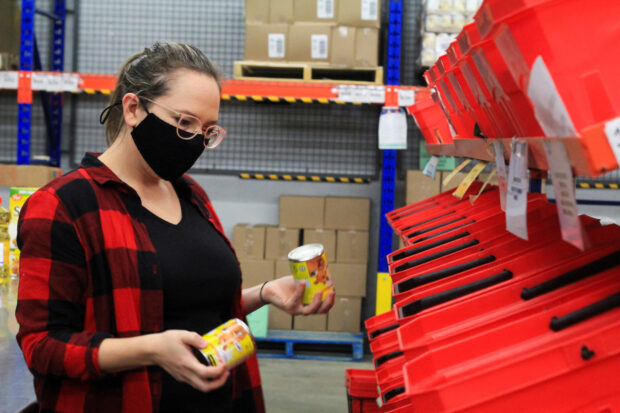Canada’s January inflation rate drops more than expected to 2.9%

A volunteer sorts through donated canned goods at the Ottawa Food Bank warehouse in Ottawa, Ontario, Canada Oct 27, 2022. REUTERS/Julie Gordon
OTTAWA – Canada’s annual inflation rate cooled much more than expected to 2.9 percent in January, largely on lower gas prices, while core inflation measures dropped to their lowest levels in more than two years, data showed on Tuesday.
Analysts polled by Reuters had forecast inflation to tick down to 3.3 percent from 3.4 percent in December. At 2.9 percent, headline inflation rate is back in the Bank of Canada’s 1 percent-3 percent control range for the first time since June 2023.
Month-over-month, the consumer price index was unchanged, compared with a forecast of a 0.4-percent rise.
Two of the Bank of Canada’s (BoC) three core measures of underlying inflation also edged down. CPI-median slowed to 3.3 percent, lowest since November 2021, while CPI-trim decreased to 3.4 percent, lowest since July 2021.
READ: Bank of Canada holds rates, policy talks shift toward when to cut
While the central bank has said single data points are not enough to sway its policy decisions, the cooldown in prices could expedite discussions about a rate cut.
The BoC has projected headline inflation to remain around 3 percent in the first half of 2024, before cooling down to 2.5 percent by the end of the year.
The BoC kept its key overnight rate at 5 percent in January and said that while underlying inflation was still a concern, the bank’s focus is shifting to when to cut borrowing costs rather than whether to hike again.
Before its last announcement in January, members of the bank’s policy-setting governing council were concerned about cutting borrowing costs too soon, especially as shelter prices continues to keep overall inflation elevated.
Lower gasoline prices
Shelter price inflation, which includes mortgage interest costs, rent and components related to house prices, accelerated to 6.2 percent in January from 6 percent in December.
The largest contributor to headline deceleration in January was lower gasoline prices, which fell 4 percent on an annual basis, Statistics Canada said. Month-over-month, gasoline prices fell 0.9 percent, marking the fifth consecutive monthly decrease.
READ: Canada’s surging cost of living fuels reverse immigration
Prices of store-bought food rose 3.4 percent – the slowest pace since August 2021 – also putting downward pressure on headline inflation.
Excluding volatile food and energy, prices rose 3.1 percent compared with a 3.4-percent rise in December.
The bank’s next rate announcement is on March 6, when the bank is expected to keep its key policy rate on hold at a 22-year high of 5 percent.
A bigger than expected job gain in January and an early estimate of a rebound in GDP growth in the last quarter of 2023 had played a part in lowering expectations of rate cuts.
Before inflation data, money markets were betting for at least 50 basis points decrease in 2024 from 125 basis points in early January.